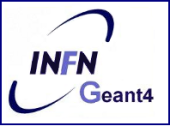Germano Russo
(INFN (Istituto Nazionale di Fisica Nucleare), Dipartimento di Fisica Sperimentale - Università di Torino, Italy)
In radiotherapy with carbon ions, the beam interaction with tissues has to be carefully
estimated, since the spatial changes in the radiation quality due to fragmentation, energy
loss and multiple scattering imply variations in the local radiobiological effectiveness. The
information of dose deposition pattern alone is not sufficient to predict the biological effect
of treatment: a detailed three-dimensional description of beam composition in terms of ion
species, kinetic energies and energy releases is needed to estimate the outcome on tumoral and
normal cells.
In the newly Italian Treatment Planning System (TPS) project, funded by the Istituto
Nazionale di Fisica Nucleare (INFN) and the Ion Beam Accelerators (IBA), this knowledge is
gathered by simulating the beam propagation by means of both Fluka and Geant4 codes.
In this talk will be presented the way this task is accomplished using Geant4, pointing out
some apparent irregularities we are finding in the results.
Keymords
radiotherapy, carbon ion, Treatment Planning System, radiobiology, clinical beam, fragmentation
Summary
The TPS kernel algorithm needs to access a lookup table where the information about the physical and radiobiological characteristics of the beam are contained.
To produce such information we are simulating with the version 9.2 of Geant4 the propagation of pencil beams in a water phantom. The phantom dimensions are automatically set depending on the primary beam energy. To record the quantities of interest, we are placing perpendicular to the beam axis a certain number of slices 10 um wide, more densely grouped in proximity of the Bragg peak, that are used as SensitiveDetectors. As an alternative, we are trying a different geometry setup that makes use of a ReadOutGeometry, such that readout is decoupled from tracking.
The recorded Hits are elaborated in the EventAction class and then saved in binary files prior to the uploading in a MySQL database for successive elaboration.
The trials we have performed up to now have revealed some apparent anomalies in the simulation: using Standard physics we have found that the position of the Bragg peak varies markedly with the setting of maximum step, while with the Low Energy physics the energy loss behavior doesn't seem compliant with the Landau-Vavilov theory.
These problems have to be analyzed and solved to allow the use of Geant4 in the production of a clinical database for carbon ion therapy.
| Are you a Memeber of the Geant4 Collaboration (yes/no) |
no
|
Ada Solano
(INFN (Istituto Nazionale di Fisica Nucleare), Dipartimento di Fisica Sperimentale - Università di Torino, Italy)
Faiza Bourhaleb
(INFN (Istituto Nazionale di Fisica Nucleare), Dipartimento di Fisica Sperimentale - Università di Torino, Italy)
Germano Russo
(INFN (Istituto Nazionale di Fisica Nucleare), Dipartimento di Fisica Sperimentale - Università di Torino, Italy)
Abdolkasem Ansarinejad
(INFN (Istituto Nazionale di Fisica Nucleare), Dipartimento di Fisica Sperimentale - Università di Torino, Italy)
Andrea Attili
(INFN (Istituto Nazionale di Fisica Nucleare), Italy)
Cristiana Peroni
(INFN (Istituto Nazionale di Fisica Nucleare), Dipartimento di Fisica Sperimentale - Università di Torino, Italy)
Elke Schmitt
(INFN (Istituto Nazionale di Fisica Nucleare), Dipartimento di Fisica Sperimentale - Università di Torino, Italy)
Flavio Marchetto
(INFN (Istituto Nazionale di Fisica Nucleare), Italy)
Marco Donetti
(INFN (Istituto Nazionale di Fisica Nucleare), CNAO (Centro Nazionale di Adroterapia Oncologica) Foundation, Italy)
Maria Adelaide Garella
(INFN (Istituto Nazionale di Fisica Nucleare), CNAO (Centro Nazionale di Adroterapia Oncologica) Foundation, Italy)
Roberto Cirio
(INFN (Istituto Nazionale di Fisica Nucleare), Dipartimento di Fisica Sperimentale - Università di Torino, Italy)
Roberto Sacchi
(INFN (Istituto Nazionale di Fisica Nucleare), Dipartimento di Fisica Sperimentale - Università di Torino, Italy)
Simona Giordanengo
(INFN (Istituto Nazionale di Fisica Nucleare), Dipartimento di Fisica Sperimentale - Università di Torino, Italy)
Vincenzo Monaco
(INFN (Istituto Nazionale di Fisica Nucleare), Dipartimento di Fisica Sperimentale - Università di Torino, Italy)




